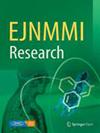癫痫手术前评估中的脑灌注SPECT:如果发作间期SPECT对发作起始区进行了高置信度侧位,是否需要额外的发作期SPECT,反之亦然?
IF 3.1
3区 医学
Q1 RADIOLOGY, NUCLEAR MEDICINE & MEDICAL IMAGING
引用次数: 0
摘要
与发作间期SPECT相比,发作间期脑灌注SPECT在识别癫痫发作起始区(SOZ)方面具有更高的灵敏度。然而,发作期 SPECT 要求较高,因为无法预测下一次癫痫发作的等待时间,无法进行发作期示踪剂注射。因此,从发作间期扫描开始,如果发作间期扫描提供了高置信度的 SOZ 候选者,则跳过发作期扫描,这可能是一种有效的方法。本研究估算了发作间期和发作期SPECT的高置信度SOZ候选者比率以及其中的假侧率。研究回顾性地纳入了177例使用99m锝-HMPAO(141例)或-ECD(36例)获得发作期和发作间期SPECT的患者(女性占48%,中位年龄38岁,四分位数范围27-48岁)。绝大多数患者被怀疑患有颞叶癫痫。SPECT 数据的目视判读由 3 位阅读者在 3 种情况下独立完成:"仅发作间期"(发作间期SPECT和统计低灌注图)、"仅发作期"(发作期SPECT和高灌注图)和 "完整 "设置(并排解读发作期和发作间期SPECT,包括统计图和SISCOM分析)。阅读者对 SOZ 进行侧位(右侧、左侧、无),并用 5 分来表示他们的信心。如果所有读者在 5 个置信点中至少有 4 个置信点偏向同一半球,则该病例被视为 "侧位置信度高"。SOZ在 "完全 "设置下的侧位被用作参考标准。在 "仅发作间期"/"仅发作期"/"完全 "设置中,"侧位置信度高 "的病例比例分别为4.5%/31.6%/38.4%。在 "仅发作间期"/"仅发作期"/"完全 "设置中,8 个 "高置信度侧位 "病例中有 1 个(12.5%)侧位至错误的半球。在 "仅发作间期 "设置中 "高置信度侧向化 "的56个病例中,有54个(96.4%)在 "完全 "设置中也侧向化,且都侧向同一半球。在癫痫手术前评估中,如果出现高置信度发作间期SOZ候选者,则应从发作间期扫描开始进行脑灌注SPECT,以跳过发作期扫描,这种方法并不实用。相反,如果是高置信度发作间期SOZ候选者,则建议从发作期扫描开始,跳过发作间期扫描。本文章由计算机程序翻译,如有差异,请以英文原文为准。
Brain perfusion SPECT in the presurgical evaluation of epilepsy: is additional ictal SPECT required in case of high-confidence lateralization of the seizure onset zone by interictal SPECT and vice versa?
Ictal brain perfusion SPECT provides higher sensitivity for the identification of the epileptic seizure onset zone (SOZ) than interictal SPECT. However, ictal SPECT is demanding due to the unpredictable waiting period for the next seizure to allow for ictal tracer injection. Thus, starting with an interictal scan and skipping the ictal scan if the interictal scan provides a SOZ candidate with high confidence could be an efficient approach. The current study estimated the rate of high-confidence SOZ candidates and the false lateralization rate among them for interictal and ictal SPECT. 177 patients (48% females, median age 38y, interquartile range 27–48y) with ictal and interictal SPECT acquired with 99mTc-HMPAO (n = 141) or -ECD (n = 36) were included retrospectively. The vast majority of the patients was suspected to have temporal lobe epilepsy. Visual interpretation of the SPECT data was performed independently by 3 readers in 3 settings: “interictal only” (interictal SPECT and statistical hypoperfusion map), “ictal only” (ictal SPECT and hyperperfusion map), and “full” setting (side-by-side interpretation of ictal and interictal SPECT including statistical maps and SISCOM analysis). The readers lateralized the SOZ (right, left, none) and characterized their confidence using a 5-score. A case was considered "lateralizing with high confidence” if all readers lateralized to the same hemisphere with at least 4 of 5 confidence points. Lateralization of the SOZ in the “full” setting was used as reference standard. The proportion of “lateralizing with high confidence” cases was 4.5/31.6/38.4% in the “interictal only”/“ictal only”/“full” setting. One (12.5%) of the 8 cases that were “lateralizing with high confidence” in the “interictal only” setting lateralized to the wrong hemisphere. Among the 56 cases that were “lateralizing with high confidence” in the “ictal only” setting, 54 (96.4%) were also lateralizing in the “full” setting, all to the same hemisphere. Starting brain perfusion SPECT in the presurgical evaluation of epilepsy with an interictal scan to skip the ictal scan in case of a high-confidence interictal SOZ candidate is not a useful approach. In contrast, starting with an ictal scan to skip the interictal scan in case of a high-confidence ictal SOZ candidate can be recommended.
求助全文
通过发布文献求助,成功后即可免费获取论文全文。
去求助
来源期刊

EJNMMI Research
RADIOLOGY, NUCLEAR MEDICINE & MEDICAL IMAGING&nb-
CiteScore
5.90
自引率
3.10%
发文量
72
审稿时长
13 weeks
期刊介绍:
EJNMMI Research publishes new basic, translational and clinical research in the field of nuclear medicine and molecular imaging. Regular features include original research articles, rapid communication of preliminary data on innovative research, interesting case reports, editorials, and letters to the editor. Educational articles on basic sciences, fundamental aspects and controversy related to pre-clinical and clinical research or ethical aspects of research are also welcome. Timely reviews provide updates on current applications, issues in imaging research and translational aspects of nuclear medicine and molecular imaging technologies.
The main emphasis is placed on the development of targeted imaging with radiopharmaceuticals within the broader context of molecular probes to enhance understanding and characterisation of the complex biological processes underlying disease and to develop, test and guide new treatment modalities, including radionuclide therapy.
 求助内容:
求助内容: 应助结果提醒方式:
应助结果提醒方式:


